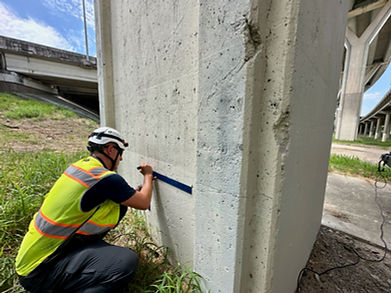
DELAYED ETTRINGITE FORMATION
INVESTIGATION + RISK ASSESSMENT + MANAGEMENT
At Durability Engineers, our experts specialize in the investigation and evaluation of Delayed Ettringite Formation (DEF), a potentially damaging durability mechanism that can compromise the integrity of concrete structures. Our focus is on diagnosing, assessing and mitigating DEF when it is suspected or has already begun to impact a structure. We assist clients in new construction, where early-age heat exposure may increase the risk of DEF, and existing structures, where distress, cracking, or unusual deterioration may indicate DEF as a potential cause.

WHAT IS DELAYED ETTRINGITE FORMATION?
Delayed Ettringite Formation (DEF) is a chemical reaction that occurs when concrete is exposed to elevated temperatures at early ages, typically above 158°F (70°C), preventing normal ettringite formation during the hydration process. Once the concete cools and moisture becomes available, ettringite can form and expand within the hardened concrete, causing internal swelling, cracking, and long-term durability issues.
RISK ASSESSMENT
When early-age concrete temperatures exceed critical thresholds, there is an increased risk of DEF, even if cracking or distress has not yet been observed. DE evaluates the potential for DEF after exceeding temperature thresholds, to help our clients make informed decisions about monitoring, mitigation, or structural implications.
-
Review of available temperature data, mixture designs, and placement records to evaluate whether DEF-critical conditions were exceeded.
-
Assessment of material chemistry and binder composition, including sulfate levels and cement type, to determine DEF susceptibility.
-
Targeted sampling and laboratory testing, such as petrography, expansion testing, or chemical analysis, to detect early indicators of DEF.
-
Development of a risk-based prognosis, including likelihood of future expansion, potential performance impacts, and recommendations for monitoring or further evaluation.


EVALUATION + ASSESSMENT
In existing structures with signs of distress or cracking, DEF may be one of several possible mechanisms contributing to long-term deterioration. DE performs condition assessments to determine whether DEF is present, how advanced it may be, and what it means for the future performance of the structure.
Our work begins with a comprehensive review of the structure’s history, construction records, and visual symptoms. We follow this with field assessments and targeted sampling, supported by laboratory analysis to confirm the diagnosis.
-
Field evaluation and documentation of distress patterns, including mapping, crack characterization, and correlation to structural features.
-
Extraction and analysis of concrete samples, using petrography, microscopy, and compositional testing to identify ettringite formation and internal cracking.
-
Interpretation of findings to distinguish DEF from other mechanisms, such as ASR, freeze-thaw damage, or sulfate attack.
-
Development of a prognosis and practical recommendations, including the potential for continued expansion, service life implications, and options for monitoring or repair.
FEATURED PUBLICATION
Lab-Based Approach to Assessing DEF Risk
Our team co-authored a 2022 peer-reviewed study introducing a novel laboratory method to evaluate the potential for DEF in mass concrete. The paper outlines how mortar bar testing can simulate early-age thermal profiles and assess the risk of future expansion.
This research supports our forensic and diagnostic approach, especially when field conditions are difficult to replicate or historical temperature data is incomplete.
Concerned about your Structure's Susceptibility to DEF, Durability Engineers Can Help...
Our team assists our clients through the development of standardized and specialty testing programs to determine the potential for DEF in new and existing structures.




